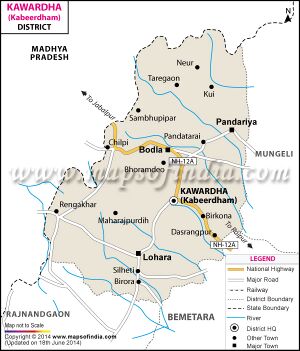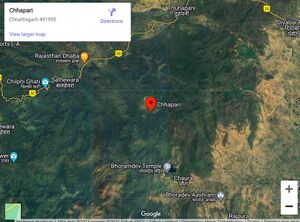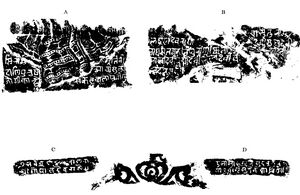Chhapri
| Author:Laxman Burdak, IFS (R) |

Chhapri (छापरी) is village in Bodla tahsil of Kawardha (Kabirdham) district in Chhattisgarh. It is located at about 17 Km from Kawardha. A temple of Shiva called Bhoramdev is a very important place historically and archaeologically is situated near it.
Variants
Jat Gotras Namesake
- Chhaparia = Chhapri is village in Bodla tahsil of Kawardha (Kabirdham) district in Chhattisgarh. It is located at about 17 Km from Kawardha. A temple of Shiva called Bhoramdev is a very important place historically and archaeologically is situated near it.
Origin
Location
It is situated 13km away from sub-district headquarter Bodla and 14km away from district headquarter Kawardha. According to Census 2011 information the location code or village code of Chhapari village is 439414. Chhapari village is located in Bodla tehsil of Kabeerdham district in Chhattisgarh, India. As per 2009 stats, Bhira is the gram panchayat of Chhapari village. The total geographical area of village is 335.75 hectares.[1]
Chhapri is a Village in Bodla Tehsil in Kabirdham District of Chattisgarh State, India. It is located 20 KM towards North from District head quarters Kawardha. 129 KM from State capital Raipur.Chhapri is surrounded by Kabirdham Tehsil towards South , Kawardha Tehsil towards South , Pandariya Tehsil towards East , S.Lohara Tehsil towards South . Kawardha , Mungeli , Malajkhand , Bemetra are the near by Cities to Chhapri. [2]
History
Chhapri Statue Inscription of Gopaladeva (Kalachuri) year 840 (1048 AD)
These inscriptions were first brought to notice by Sir A Cunningham who published transcripts of them together with a photozincograph in bis Archœological Survey of India Reports, Vol XVII (1881-82), pp 34 ff and plate xxii. They were subsequently noticed by Rai Bahadut Hiralal in his Inscriptions in C P and Berar. They are edited here from estampages kindly supplied by Mr M A Suboor of the Central Museum, Nagpur.
The inscriptions are incised on the pedestal of a large statue. The temple of Boramdeo, in which the inscribed statue is now placed, is situated at the western end of a long embankment which forms a lake in the valley near Chhapri, 11 miles east of Kawardha, in the Chhattisgarh Division of Madhya Pradesh. The statue is of a bearded man sitting with folded hands, and measures 2'-7" high and 1' 11" broad. On its pedestal is figured a Raja on horseback with an attendant carrying an umbrella and a female offering food to the horse. To the right is a Jogi seated with knees bound.
The inscriptions are four in number. Two of them, called here A and B, are divided by the dress of the statue into two parts. The characters of all are Nagari of about the eleventh century A C. The average size of the letters is 4"
|
A १. स्रि(श्री)राम - मूर्ति वी - २.दाणि पुरुषा- त्मा वासुल - ३. जोगी कान्हो सकलकलाप्रवीणु(ण) [।*] B १. लषणदेवरायो वासु[ल]रामु २. रायमतगज सिघुराणी माता- देवी सुधा देवी ३. रातादेवी पद्मादेवी [सी]लादेवी वा- तादेवी ४. नदतु सकु C १. सिद्धि [।*] संवत ८४० राणक २.श्री गोपालदेवराज्ये ॥ D १. उमा माहेस्व[र] सुन्दरतरं २. साधु धागुसुतेन कारितं |
| Chhapri Statue Inscription of Gopaladeva (Kalachuri) year 840 (1048 AD)[3] |
The language is Sanskrit. The only orthogtaphical peculiarity that calls for notice is the use of sh for kh (representing the Sanskrit kshma) in Lashanadêvaràyô inL-1 of B.
The first of these inscriptions (A) names Jôgï Kânhô and describes him as proficient in all arts and as a human incarnation of the illustrious Rama. He is evidently the personage whom the statue was intended to represent. Cunningham took him to be identical with the Jôgï figured on the pedestal of the image and thought that he was the religious adviser of the Râjâ on horseback, whom he considered to be the builder of the temple. The second inscription (B) gives the names of the king Lakshmanadeva and his crowned queen, son and daughters. The third record (C) gives the date as Samvat 840 (expressed in decimal figures only) during the reign of the Rānaka, the illustrious Gopāladeva, while the last one (D) states that the very beautiful image of Umā-Mahesvara was caused to be made by Sādhu, the son of Dhāngu.
The date of the inscription must, on palœographic grounds, be referred to the Kalachuri era and would correspond to 1048-49 A.C. It does not admit of verification. The use of the Kalachuri era suggests that Gopāladeva was a feudatory of the Kalachuri ruler of Ratanpur. It may be noted in this connection that some other inscriptions in and near the temple of Boramdeo, dating from the 14th to the 16th century A. C. , are recorded in the Vikrama era. Lakshmanadeva seems to have been a petty chief under Gôpàladëva.
The temple of Boramdeo has been praised by Cunningham as one of the most richly decorated temples that he had seen. It is so called because it was used in later times by the Gonds for the worship of their god. The sanctum of the temple contains at present an image of the snake-god besides a Siva-Linga; but from the figure of Vishnu over the middle of the three entrances of the temple, Cunningham conjectured that it was originally dedicated to Vishnu. He actually found under a tree a few paces to the eastward a sculpture, figuring Vishnu and Lakshmi sitting on Garuda. Inscription D, however, refers to an image of Umâ-Mahësvara. Perhaps the statue, on which these inscriptions are incised, was originally put up at some other temple dedicated to Umâ-Mahësvara. It may be noted in this connection that Cunningham has described another old temple situated to the north of the temple of Boramdeo, the sanctum of which contains in addition to an argha in situ, a small group of Hara-Gauri. It is perhaps this latter image which is mentioned in inscription D.
Translation
A
The excellent Jogi Kānhô, the present incarnation, in human form, of the illustiious Rāma, who is proficient in all arts.
B
The king Lakshmanadêva, the excellent Rāma, the elephant-like king, the queen mother Singhurāni, the princess Sudhā, the princess Rātā, the princess Padmā, the princess Sīlā, the princess Vātā — May (these) be able to rejoice !
C
Success ! In the year 840, during the reign of the illustrious Gopāladeva.
D
The very beautiful (images of) Umā and Mahesvara have been caused to be made by Sādhu, the son of Dhāngu.
Notes by Wiki Editor
- Saka era - The inscription refers the Saka era and not the Kalachuri era as indicated.
- Jogi Kānhô - Name and style indicates its Rajasthani origin as nouns end in 'o' in Rajasthani language.
- Gopaladeva - See the ancestry of Nagavanshi rulers in Kawardha. Gopaladeva is mentioned at S.No. 6. He must be an independent ruler and not a feudatory of Kalachuri rulers of Ratanpur.
- Rānaka - Seems title and needs further research
- The period of Inscription 1048 AD is contemporary of Nagavanshi rulers ancestors of Tejaji (1074- 1103 AD) in Nagaur district of Rajasthan.
- Chhapri - Villages of this name are also found in Rajasthan and Madhya Pradesh:
- Barmer tahsil in Barmer district
- Bhilwara tahsil in Bhilwara district
- Kapasan tahsil in Chittorgarh district
- Phagi and Phulera tahsils in Jaipur district.
- Chhapri Kalan (छापरी कलां), Chhapri Khurd (छापरी खुर्द) in Didwana in Nagaur district
- Alot (आलोट) tahsil in Ratlam district in Madhya Pradesh.
- Tarana (तराना) tahsil in Ujjain district in Madhya Pradesh.
This shows us about the movement of these people from Rajasthan to Malwa in Madhya Pradesh and then to Kawardha.
Population
Chhapari has a total population of 513 peoples, out of which male population is 251 while female population is 262. Literacy rate of chhapari village is 51.07% out of which 62.95% males and 39.69% females are literate. There are about 133 houses in chhapari village. Pincode of chhapari village locality is 495674. Kawardha is nearest town to chhapari for all major economic activities, which is approximately 14km away.[4]
References
- ↑ https://villageinfo.in/chhattisgarh/kabeerdham/bodla/chhapari.html
- ↑ https://www.onefivenine.com/india/villages/Kabirdham/Bodla/Chhapri
- ↑ Corpus Inscriptionium Indicarium Vol IV Part 2 Inscriptions of the Kalachuri-Chedi Era, Vasudev Vishnu Mirashi, 1905, p. 581
- ↑ https://villageinfo.in/chhattisgarh/kabeerdham/bodla/chhapari.html
Back to Jat Villages

